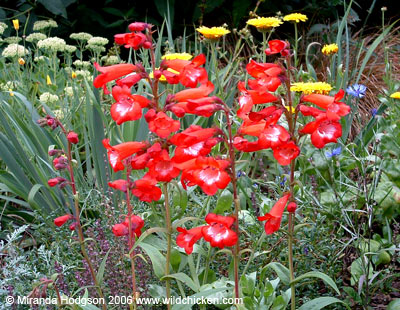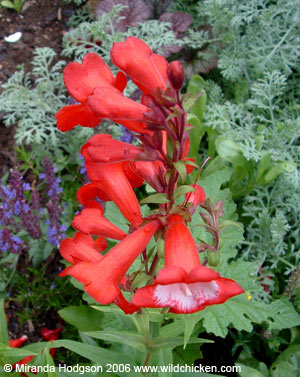


Penstemon 'Rubicundus' (also called Penstemon ‘Heythrop Park’)
Penstemon
'Rubicundus' or ‘Heythrop Park’
Upright semi-evergreen perennial, good for a prominent position in mixed borders.
I didn't intend this plant to be combined with bright yellow pot marigolds - they appeared on their own - but they were so popular with the bees and other insects that I left them there. In the end there was a certain je ne sais quois about it, but I'm not convinced it'll happen again. The combination I actually wanted was with the purple flowers of the Salvias and the grey-green foliage and white flowers of the Anthemis punctata subsp. cupaniana.
The flowers are very similar to those of our common foxglove (Digitalis purpurea), which is not surprising as they come from the same family, Scrophulariaceae.
Penstemons are popular with bumblebees and as this one has a larger flower, it means that the bigger bumblebees can get in.
Flowers in summer.
Habit - Upright. H: 1m S: 50cm.
Stems - straight, rounded, smooth, green tinged with reddish-brown.
Leaves - dark to mid-green, lanceolate, smooth-edged.
Flowers - bright red trumpets with white throats.
Does best in full sun, but can manage partial shade.
Fertile, well-drained.
Not fully hardy and may need winter protection in cold areas, especially those with clay soil. Here, with our free-draining sandy soil, it survives winter without protection.
Deadhead to prolong flowering and cut back in winter if you plan to cover with a protective mulch. If you live in a colder area, it might be an idea to take some cuttings, just in case.
May have problems with slugs, snails and chrysanthemum eelworms.
Division in spring, softwood cuttings in spring or semi-ripe cuttings in summer.
Garden Plant Information list of plant care info by botanical name